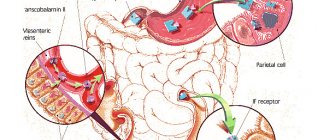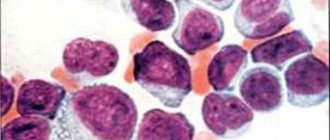Author:
Amelicheva Alena Aleksandrovna medical editor
Quick Transition Treatment of Addison's Disease
Addison's disease (hypocorticism, chronic adrenal insufficiency) is a rare disease characterized by insufficient production of the glucocorticoid hormone cortisol and the mineralocorticoid hormone aldosterone by the adrenal glands.
Most often, hypocortisolism, which affects both men and women, occurs at the age of 30-50, but the onset (first clinical manifestation) of the disease can be observed at any age.
The worldwide prevalence of Addison's disease is 40-60 patients diagnosed with AD per 1 million people.
Forms of Addison's disease
Depending on the cause, Addison's disease is:
- Primary. Caused by insufficient functioning or damage to the adrenal cortex itself.
- Secondary. The anterior lobe of the pituitary gland secretes an insufficient amount of adrenocorticotropic hormone, which leads to a decrease in the secretion of hormones by the adrenal cortex.
- Iatrogenic. Long-term use of corticosteroid drugs leads to atrophy of the adrenal glands, in addition, it disrupts the connection between the hypothalamus, pituitary gland and adrenal glands.
Differential diagnosis
Most often, Addison's disease is differentiated (distinguished) from the following diseases:
- secondary adrenal insufficiency caused by a decrease in the production of adrenocorticotropic hormone by the pituitary gland;
- congenital adrenal hyperplasia (a group of hereditary pathologies arising due to impaired cortisol biosynthesis);
- adrenoleukodystrophy (hereditary degenerative disease of the central nervous system, which is transmitted in an X-linked recessive manner and is associated with adrenal insufficiency);
- autoimmune polyendocrine syndrome type 2 (Schmidt syndrome, a rare autoimmune disease in which there is a sharp decrease in the function of several endocrine organs: adrenal glands, thyroid gland, parathyroid glands, gonads, pancreas);
- autoimmune polyendocrine syndrome type 1 (a rare genetic syndrome APECED, which is characterized by lesions of the skin and mucous membranes by Candida fungi, decreased function of the parathyroid glands and autoimmune insufficiency of adrenal function).
Causes of Addison's disease
Addison's disease and adrenal hypofunction can develop as a result of such processes and pathologies as:
- tuberculous, syphilitic, brucellosis lesions;
- purulent inflammation;
- decreased sensitivity or ACTH deficiency;
- taking exogenous corticosteroids, which provokes adrenal atrophy;
- development of non-hormone-producing tumors;
- congenital dysfunction;
- sarcoidosis;
- amyloidosis;
- drug therapy, for example, clodatin, etomidate, spironolactone, ketoconazole, as well as barbiturates, steroidogenesis blockers.
Pathogenesis
There are many mechanisms of damage to the adrenal cortex, causing insufficiency in the production of hormones - hypocorticism , or their complete absence - acorticism . These include:
- autoimmune reactions (in 85% of cases) - antibodies to the adrenal cortex are synthesized in the body - immunoglobulins M , lymphoid infiltration, fibrosis and atrophy of functioning glandular cells occur;
- infections – introduced into the adrenal glands hematogenously, most often causing caseous necrosis and calcification;
- underdevelopment ( hypoplasia );
- oncology;
- genetic defects and diseases, such as hemochromatosis ;
- injuries;
- poisoning;
- impaired sensitivity or synthesis of adrenocorticotropic hormone (ACTH) as a result of ischemia, radiation, etc.
The structure of the adrenal glands
Hormones of the adrenal cortex and their significance
Hormones produced in the morphofunctional cortical layer of the adrenal glands are corticosteroids . Among them, the most active and important are:
- Cortisol is a glucocorticoid synthesized in the zona fasciculata of the cortex. Its main function is the regulation of carbohydrate metabolism, stimulation of gluconeogenesis and participation in the development of stress reactions. The conservation of energy resources is realized through the binding of cortisol to liver receptors and other target cells, which causes activation of glucose , its storage in the form of glycogen against the background of a decrease in catabolic processes in the muscles.
- Cortisone is a glucocorticoid, second in importance after cortisol, which can stimulate the synthesis of carbohydrates and proteins, inhibit the immune system, and increase the body's resistance to stressful situations.
- Aldosterone is the main human mineralocorticoid, synthesized in the zona glomerulosa of the cortex, under its action tissues are able to retain water and chlorides, sodium reabsorption and potassium excretion are enhanced, a shift towards alkalosis occurs, blood pressure and circulating blood volumes increase.
- Corticosterone is a less significant mineralocorticoid hormone; it also has glucocorticoid activity, although half that of cortisol, which is realized primarily in stimulating liver gluconeogenesis.
- Deoxycorticosterone is a minor, low-active mineralocorticosteroid hormone that can regulate water-salt metabolism and increase the strength and endurance of striated muscles.
Symptoms of Addison's disease
The initial symptoms of Addison's disease, such as fatigue, lack of energy, and muscle weakness, are similar to those of many other health conditions, such as depression, the flu virus, or chronic fatigue syndrome.
Initial symptoms
Dehydration may be an early sign of Addison's disease. This is caused by a lack of the hormone aldosterone in the body, which is used to regulate the balance of salt and water.
Other initial symptoms of Addison's disease include:
- fatigue (lack of energy or motivation);
- lethargy (pathological sleepiness or fatigue);
- muscle weakness;
- bad mood (mild depression) or irritability;
- lack of appetite and unintentional weight loss;
- low blood pressure (hypotension);
- increased thirst;
- craving for salty foods;
- hypoglycemia (low blood sugar)
Progressive symptoms
The symptoms listed above may increase in frequency or severity, and symptoms such as:
- postural or orthostatic hypotension (low blood pressure when standing up);
- dizziness and fainting (sudden, temporary loss of consciousness);
- nausea (feeling like you're going to get sick);
- vomiting and diarrhea;
- pain in the abdomen, joints or back;
- muscle spasms (when muscles suddenly contract for several seconds or minutes and you cannot control them);
- chronic exhaustion, which can cause depression;
- brownish discoloration of the skin (hyperpigmentation), especially in the creases of the palms of the hands, scars, or pressure points such as knuckles or knees (see photo above);
- Women have low libido (lack of interest in sex).
The most characteristic sign of Addison's disease is dark brown, brown skin color (pigmentation) with a bronze, smoky tint. Pigmentation can be especially pronounced on open parts of the body (face, neck, especially its back surface, hands), on normally pigmented parts (around the nipples, in the armpits, external genitalia, perineum, around the anus), as well as in places exposed to constant friction (inner thighs, waist, neck, etc.). The palms, soles, and nail beds of the hands are not pigmented. Pigmentation appears quite early on the mucous membrane of the mouth, cheeks, hard palate, lips, and gums.
Pigmentation in Addison's disease consists of large diffuse spots, against which there are darker spots the size of a pinhead or millet grain. Pigmentation, initially unsharp, will gradually increase, the skin becomes darker and bronzer; The primary affected areas are especially sharply colored.
Prevalence
Primary adrenal insufficiency is rare: according to domestic authors, it occurs in 1 in 4000-6000 hospitalized patients. American endocrinologists provide data on 39-60 cases of adrenal insufficiency per 1 million population. Chronic adrenal insufficiency (CAI) is more common in men; The ratio of men to women suffering from this disease is 2:1. According to German doctors - Oelkers and his colleagues - the average age at which the disease is diagnosed is 40 years (from 17 to 72).
Addisonian crisis
If Addison's disease is left untreated, the levels of cortisol and aldosterone in the body will gradually decrease. This will cause progressive worsening of symptoms and will eventually lead to a situation known as Addisonian crisis.
An Addisonian crisis is when the symptoms of Addison's disease come on very quickly and very strongly. The condition may develop when the above symptoms become worse.
Addisonian crisis is a medical emergency. If left untreated, it can be fatal. If you or someone you know has Addison's disease and any of the symptoms listed below occur, call an ambulance (numbers: 103, 112).
Symptoms of Addisonian crisis:
- severe dehydration;
- severe hypotension;
- shock (when organs and tissues do not receive enough blood);
- severe vomiting and diarrhea;
- extreme muscle weakness;
- headache;
- extreme drowsiness or coma;
- death.
Classification
Depending on the mechanism of development of Addison's or otherwise bronze disease, the following are distinguished:
- primary insufficiency of the adrenal cortex - the basis of the pathology is damage to the glandular structures directly;
- secondary failure - as a result of a violation of the hypothalamic-pituitary system , which normally should stimulate the adrenal cortex.
Acute adrenal insufficiency is called hypoadrenal or Addison's crisis .
Features of Addisonian crisis
Addisonian crisis develops suddenly and can threaten a person’s life. Low concentrations of hormones (cortisol, aldosterone) in the bloodstream lead to loss of consciousness or psychosis, confusion, delirium, fever , severe vomiting and diarrhea , mineral and water imbalances, pain in the legs, lower back, abdomen, low blood pressure and even cause shock .
Diagnosis of Addison's disease
Diagnosis of Addison's disease is based on laboratory tests and special tests. Instrumental methods are used if it is necessary to determine the degree of changes in the adrenal glands during a long-term pathological process.
To confirm Addison's disease you need to do:
- ultrasound examination of the adrenal glands to identify lesions, for example in tuberculosis;
- blood test to determine the level of adrenal hormones (cortisol), ACTH, glucose, potassium, sodium, renin;
- CT scan of the adrenal glands, which allows you to detect adrenal infarction, reduction in size, tumor metastases, amyloidosis;
- MRI of the brain to study the hypothalamic-pituitary region and detect destructive, tumor or granulomatous processes.
Laboratory tests for Addison Birmer's disease
The patient must submit:
- complete blood count (usually increased hematocrit);
- blood biochemistry (sodium concentration is reduced, potassium concentration is increased);
- general urine analysis (the concentration of metabolic products of testosterone (17 ketosteroids) and glucocorticoids (17 oxyketosteroids) is reduced).
Laboratory tests also show a decrease in testosterone, aldosterone, and cortisol levels.
Diagnostic tests for Addison's disease
Diagnostic tests for Addison's disease are aimed at determining which endocrine organ is primarily affected. If the pathology concerns only the adrenal glands and does not affect the pituitary gland and hypothalamus, a decrease in the level of hormones of the adrenal cortex is diagnosed against the background of an increase in the concentration of hormonally active substances produced by the pituitary gland and hypothalamus.
The patient may be prescribed the following tests:
- Using adrenocorticotropic hormone (ACTH). ACTH is a pituitary hormone responsible for the production of hormones by the adrenal cortex. In healthy people, the concentration of aldosterone and cortisol doubles half an hour after its administration. If Addison's disease is present, the numbers do not change.
- Test with synacthen depot. Synacthen is a synthetic analogue of adrenocorticotropic hormone. Normally, it increases the secretion of cortisol, but this does not happen in patients, since the affected adrenal glands are not able to respond to the stimulating effect. Accordingly, the hormones cortisol and aldosterone remain at the same level.
General information
Addison's disease is a chronic failure of the adrenal cortex, manifested in a decrease or cessation of the secretion of hormones - mineralocorticoids and glucocorticoids ( aldosterone , cortisol , cortisone , corticosterone , deoxycorticosterone and other corticosteroids).
A deficiency of mineralocorticoid hormones leads to increased sodium excretion and decreased potassium excretion, mainly in urine, but also in sweat and saliva, while electrolyte imbalance causes severe dehydration, plasma hypertonicity, acidosis , decreased circulating blood volume, hypotension and even circulatory collapse . However, if the pathology is caused by decreased ACTH , electrolyte levels remain normal or moderately altered. Whereas a lack of glucocorticoids causes the following symptoms of Addison's disease: changes in insulin and impaired carbohydrate, protein and fat metabolism. As a result, carbohydrates necessary for life are formed from proteins, blood sugar levels decrease, glycogen deposited in the liver are depleted, which is expressed in general, muscle, and including myocardial weakness. Patients' resistance to viruses and infections, injuries and various types of stress . As failure develops, cardiac output decreases and circulatory failure occurs.
If the level of plasma cortisol is reduced, then ACTH synthesis is stimulated and the level of β-lipotropic hormone , which has melanocyte-stimulating activity, which, together with tropin, produces hyperpigmentation . People not only have bronze skin, but also mucous membranes. This means that secondary failure resulting from functional disorders of the pituitary gland does not manifest itself in the form of hyperpigmentation.
This endocrine disorder is quite rare - 4-6 people per 100 thousand in statistics from different countries. It was first described by the English physician, the father of endocrinology, Thomas Addison back in 1855 in the book “On the Constitutional and Local Consequences of Diseases of the Adrenal Cortex.”
Thomas Addison and his book
Treatment of Addison's disease
The main treatment for primary hypocortisolism is hormone replacement therapy. The lack of cortisol can be replenished with hydrocortisone, and aldosterone with fludrocortisone acetate.
In addition, during treatment it is important to eliminate the consequences of dehydration, carry out symptomatic therapy - eliminate manifestations of cardiac and respiratory failure, and if an infection is detected - prescribe antibacterial drugs.
Synthetic glucocorticoids are used to replace cortisol. This is usually hydrocortisone. Other possible medications are prednisolone or dexamethasone, although these are less commonly prescribed.
Aldosterone is replaced with oral doses of a mineralocorticoid called fludrocortisone. Your doctor may also ask you to include salty foods in your daily diet, although this is not necessary if you are taking enough fludrocortisone.
Addison's disease should not affect the quality and length of life. Diet, exercise and daily routine can continue as usual. With medication, the symptoms of Addison's disease should completely disappear.
Relieving symptoms of Addison's disease
In order to normalize the disturbed electrolyte balance and replenish the volume of lost fluid, physiological sodium chloride solution is injected intravenously.
If the glucose level is low, a five percent glucose solution is administered intravenously.
Also, during treatment of the pathology, the doctor must monitor the patient’s body weight, monitor his blood pressure, and periodically prescribe a urine test for the concentration of 17-KS and 17-OX.
In a situation where Addison's disease is caused by tuberculosis, it is recommended to take anti-tuberculosis drugs, for example, Streptomycin or Isoniazid.
Diet for adrenal insufficiency
Diet 15 table
- Efficacy: therapeutic effect after 2 weeks
- Timing: constantly
- Cost of food: 1600-1800 rubles per week
In addition to the fact that the patient needs to avoid hypothermia and stressful situations, a diet rich in carbohydrates is recommended. You need to add foods with a high amount of ascorbic acid (black currants, citrus fruits, rosehip decoction) and an additional 15-20 g of table salt per day to your diet.
To prevent hyperkalemia, it is better to limit the consumption of potassium-rich dried apricots, raisins, legumes, and potatoes.
Mode
Addison's syndrome does not allow patients to engage in heavy physical labor. Any stressful condition (infection, physical or mental stress, etc.) requires an increase in glucocorticoid intake. The principle of clinical observation in relation to these patients must be strictly observed. All patients with Addison's syndrome are provided with a special leaflet, which indicates a rational schedule for taking corticosteroids and the optimal single and daily doses of various corticosteroid drugs for a given patient. In case of an urgent situation, glucocorticoids should be ready for parenteral administration. Warning information should also be prepared for doctors in case the patient is unable to independently provide information about his illness. Patients should be aware that they should consult a doctor immediately if they experience weakness, malaise, fever, abdominal pain, diarrhea, or other signs of worsening condition. Drinking alcohol, taking barbiturate sleeping pills, and using alkaline mineral waters to wash down tablets containing corticosteroids are prohibited.
1. Balabolkin M. I. Endocrinology, 1998 2. McDermott M. Secrets of endocrinology, 2001 3. Wolfgang Oelkers M. Adrenal issuficiency. The New England Journal of Medicine, Vol. 335, no. 16, p. 1206-1212 https://www.temple.edu/imreports/Reading/Endo%20%20-Adrenal%20insuff.pdf 4. May M., Vaughn E., Carey R. Adrenocortical insufficiency - clinical aspects. In: Adrenal disorders, 1989, p. 171-189 5. Oelkers W., Diederich S., Bähr V. Recent advances in diagnosis and therapy of Addison's disease. Journal of Endocrinology Vol. 1. 1994, p. 69-80









